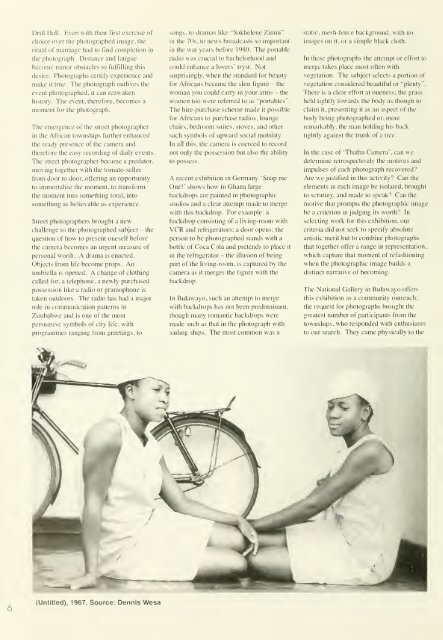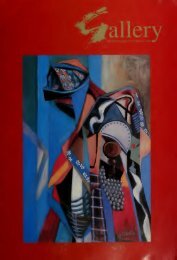Untitled - gallery delta
Untitled - gallery delta
Untitled - gallery delta
Create successful ePaper yourself
Turn your PDF publications into a flip-book with our unique Google optimized e-Paper software.
Drill Hall. Even with their first exercise of<br />
choice over the photographed image, the<br />
ritual of marriage had to find completion in<br />
the photograph. Distance and fatigue<br />
become minor obstacles to fulfilling this<br />
desire. Photographs certify experience and<br />
make it true. The photograph outlives the<br />
event photographed; it can reawaken<br />
history. The event, therefore, becomes a<br />
moment for the photograph.<br />
The emergence of the street photographer<br />
in the African townships further enhanced<br />
the ready presence of the camera and<br />
therefore the easy recording of daily events.<br />
The street photographer became a predator,<br />
moving together with the tomato-seller<br />
from door to door, offering an opportunity<br />
to immortalise the moment, to transform<br />
the moment into something total, into<br />
something as believable as experience.<br />
Street photographers brought a new<br />
challenge to the photographed subject - the<br />
question of how to present oneself before<br />
the camera becomes an urgent measure of<br />
personal worth. A drama is enacted.<br />
Objects from life become props. An<br />
umbrella is opened. A change of clothing<br />
called for, a telephone, a newly purcha.sed<br />
pos.session like a radio or gramophone is<br />
taken outdoors. The radio has had a major<br />
role in communication patterns in<br />
Zimbabwe and is one of the most<br />
persuasive symbols of city life, with<br />
programmes ranging from greetings, to<br />
(<strong>Untitled</strong>), 1967. Source: Dennis Wesa<br />
songs, to dramas like "Sakhelene Zinini"<br />
in the 70s, to news broadcasts so important<br />
in the war years before 1980. The portable<br />
radio was crucial to bachelorhood and<br />
could enhance a lovers' tryst. Not<br />
surprisingly, when the standard for beauty<br />
for Africans became the slim figure - the<br />
woman you could carry in your arms - the<br />
women too were referred to as "portables".<br />
The hire-purchase scheme made it possible<br />
for Africans to purchase radios, lounge<br />
chairs, bedroom suites, stoves, and other<br />
such symbols of upward social mobility.<br />
In all this, the camera is coerced to record<br />
not only the possession but also the ability<br />
to possess.<br />
A recent exhibition in Germany 'Snap me<br />
One!" shows how in Ghana large<br />
backdrops are painted in photographic<br />
studios and a clear attempt made to merge<br />
with this backdrop. For example: a<br />
backdrop consisting of a living-room with<br />
VCR and refrigerators; a door opens; the<br />
person to be photographed stands with a<br />
bottle of Coca Cola and pretends to place it<br />
in the refrigerator - the illusion of being<br />
part of the living-room, is captured by the<br />
camera as it merges the figure with the<br />
backdrop.<br />
In Bulawayo, such an attempt to merge<br />
with backdrops has not been predominant,<br />
though many romantic backdrops were<br />
made such as that in the photograph with<br />
sailing ships. The most common was a<br />
static, mesh-fence background, with no<br />
images on it. or a simple black cloth.<br />
In these photographs the attempt or effort to<br />
merge takes place mo.st often with<br />
vegetation. The subject selects a portion of<br />
vegetation considered beautiful or "plenty".<br />
There is a clear effort at oneness; the grass<br />
held tightly towards the body as though to<br />
claim it, presenting it as an aspect of the<br />
body being photographed or, more<br />
remarkably, the man holding his back<br />
tightly against the trunk of a tree.<br />
In the case of "Thatha Camera', can we<br />
determine retrospectively the motives and<br />
impulses of each photograph recovered?<br />
Are we justified in this activity? Can the<br />
elements in each image be isolated, brought<br />
to scrutiny, and made to speak? Can the<br />
motive that prompts the photographic image<br />
be a criterion in judging its worth? In<br />
selecting work for this exhibition, our<br />
criteria did not seek to specify absolute<br />
artistic merit but to combine photographs<br />
that together offer a range in representation,<br />
which capture that moment of refashioning<br />
when the photographic image builds a<br />
distinct narrative of becoming.<br />
The National Gallery in Bulawayo offers<br />
this exhibition as a community outreach;<br />
the request for photographs brought the<br />
greatest number of participants from the<br />
townships, who responded with enthusiasm<br />
to our search. They came physically to the<br />
^^\<br />
d ,..>/<br />
^







